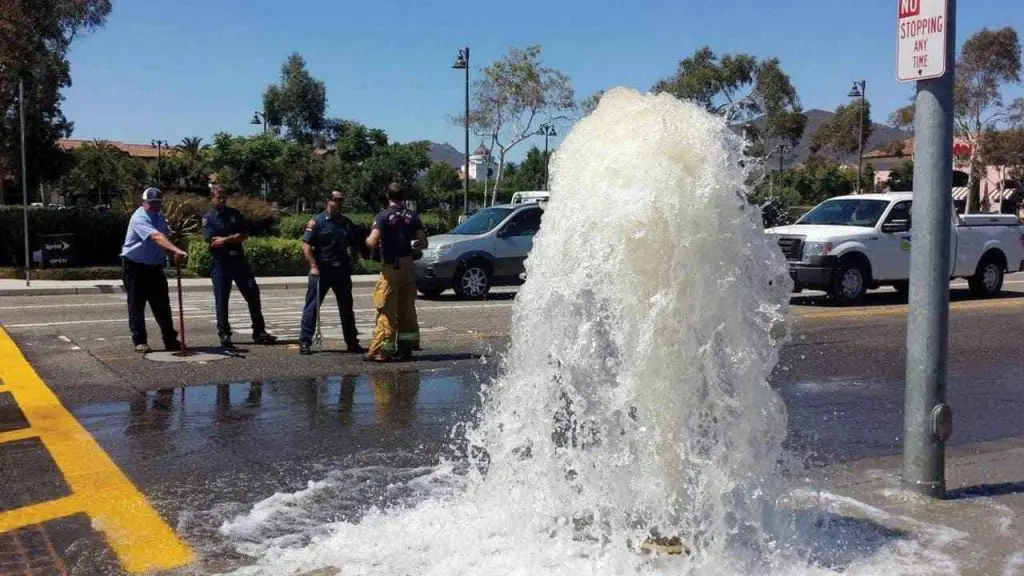A fire hydrant is a critical component of a community’s fire-fighting infrastructure. It provides a source of water that is essential in fighting fires and saving lives.
Unfortunately, sometimes these hydrants can be hit by vehicles, causing significant damage and disrupting essential services.
The consequences of hitting a fire hydrant can be far-reaching, impacting both the person responsible for the collision and the community at large.
In addition to physical damage, there can be legal, financial, and insurance implications, as well as potential consequences for emergency services.
This article will outline the consequences and preventative measures that one should be aware of if involved in a collision with a fire hydrant.
What Happens If You Hit A Fire Hydrant?

Physical Damage
When a vehicle hits a fire hydrant, the damage can be extensive. The vehicle may suffer extensive damage to its front end, including bent metal, broken glass, and other damage.
The fire hydrant itself may also be severely damaged, potentially rendering it inoperable. Additionally, surrounding property, such as sidewalks, street signs, and other infrastructure may also be impacted.
It is important to note that the cost of repairing a damaged fire hydrant can be substantial, as it requires specialized equipment and expertise.
Furthermore, a damaged fire hydrant may pose a hazard to the public, as broken pipes and other debris can be scattered around the site of the collision.
This highlights the importance of taking preventative measures to avoid collisions with fire hydrants and to report any incidents promptly.
Legal Consequences
In addition to the financial costs, hitting a fire hydrant can also result in legal consequences.
Depending on the circumstances of the collision, the person responsible may face charges of reckless driving, hit and run, or even criminal mischief. These charges can result in fines, penalties, and even jail time.
The severity of the charges will depend on the jurisdiction and the circumstances of the collision.
Furthermore, the person responsible for the collision may also be held liable for the cost of repairing the damaged fire hydrant and any other property damage.
This can result in substantial out-of-pocket expenses and may impact their insurance rates for years to come. It is important to consult with an attorney to understand the legal implications of a collision with a fire hydrant.
Additionally, individuals should always contact the authorities immediately following a collision to ensure that proper reporting procedures are followed and to minimize the risk of legal consequences.
Impact on Emergency Services
Hitting a fire hydrant can have serious consequences for emergency services in the affected area. Damaged fire hydrants can lead to disruptions in the water supply which is critical for fire-fighting efforts.
In some cases, this can result in the delay or inability of firefighters to effectively contain and extinguish a fire. This can put lives and property at risk.
Furthermore, damaged fire hydrants may pose a hazard to the public, as broken pipes and other debris can be scattered around the site of the collision.
This highlights the importance of prompt reporting of any incidents to ensure that the damaged hydrant can be repaired as quickly as possible to minimize the impact on emergency services.
Additionally, taking preventative measures to avoid collisions with fire hydrants is crucial to ensure the safety and well-being of the community and the continued effective functioning of emergency services.
Prevention and Awareness
Preventing collisions with fire hydrants is essential to ensure the safety and well-being of the community, as well as to minimize the legal, financial, and insurance implications for the person responsible.
There are several steps that individuals can take to avoid hitting fire hydrants, including:
- Paying attention while driving: Distracted driving is a leading cause of collisions with fire hydrants. Drivers should avoid distractions such as texting, eating, or using their phones while behind the wheel.
- Observing traffic signals and signs: Following traffic signals and signs are essential to avoid collisions with fire hydrants. Drivers should always obey traffic signals and signs, such as stop signs and yield signs, to reduce the risk of collisions.
- Keeping a safe following distance: Maintaining a safe following distance is important to give yourself enough time to react if an unexpected obstacle, such as a fire hydrant, suddenly appears.
- Being aware of your surroundings: Familiarizing yourself with your surroundings, including the location of fire hydrants, can help you avoid collisions.
In addition to taking these preventative measures, it is also important for individuals to be aware of the consequences of hitting a fire hydrant.
This awareness can help individuals make informed decisions and prioritize safety on the road.
Financial Considerations
The financial implications of hitting a fire hydrant can be significant. The cost of repairs to the vehicle, hydrant, and surrounding property can add up quickly, and fines and penalties imposed by local authorities can also be substantial.
Additionally, the potential loss of income due to vehicle downtime and repairs can be substantial. It is important to have adequate insurance coverage to mitigate the financial impact of a collision with a fire hydrant.
Community Involvement
Community involvement is critical to maintaining and repairing damaged fire hydrants. If a collision occurs, it is essential to report it to local authorities as quickly as possible.
The community can also support maintenance and replacement efforts for damaged hydrants through public education and awareness campaigns.
By working together, communities can ensure that their fire hydrants are functioning properly and that essential services are not disrupted.
Conclusion
In conclusion, hitting a fire hydrant can have far-reaching consequences for both the person responsible for the collision and the community.
From physical damage to legal and financial implications, as well as the potential impact on emergency services, the effects can be substantial.
Preventative measures, such as paying attention while driving, observing traffic signals, keeping a safe following distance, and being aware of your surroundings, can help to avoid collisions.
Financial considerations, such as having adequate insurance coverage, can help mitigate the financial impact.
Community involvement, including prompt reporting of incidents and public education and awareness campaigns, is critical in maintaining and repairing damaged hydrants.
To ensure the safety and well-being of the community and the effective functioning of emergency services, it is important to prioritize preventative measures and be aware of the consequences of hitting a fire hydrant.
Additional Posts:


